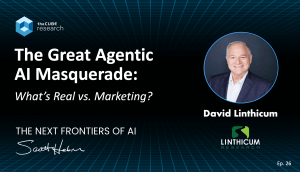We are now beginning to see real ROI from Agentic AI investments, not just from productivity gains through task automation, but also from transformative business outcomes driven by enhanced knowledge work that is revitalizing entire industries. One clear proof point is how Agentic AI powered Vantaca’s $1.25B unicorn valuation, showcasing how digital labor can drive measurable, transformative outcomes.
Vantaca, an AI-first community association management platform provider, announced on October 10th, 2025, that they have secured a $300 million minority growth investment led by Cove Hill Partners at a $1.25 billion valuation, officially attaining unicorn status.
The investment reaffirms Vantaca’s position as the leading platform for community association management software, and its related agentic AI knowledge worker portfolio demonstrates investor confidence in its AI-driven digital labor strategy. It also marks an industry milestone in how pioneers are translating agentic AI technologies into transformative business outcomes.
The Wilmington, N.C.–based company has been on the Inc. 5000 list for five straight years, thanks to 278% growth over the last three years. It serves more than 500 management companies and six million households across the country. This achievement far exceeds the SaaS sector averages, almost six times the median and nearly double the top-quartile growth rates for companies in their revenue range, according to SaaS Capital and OpenView benchmarks.
Ben Currin, CEO of Vantaca on this major milestone:
“This investment validates what our customers and industry partners already know—that Vantaca is defining the future of community management through AI-native automation and operational excellence. It accelerates our mission to help management companies scale profitably while delivering exceptional homeowner experiences.”
About Vantaca
Vantaca provides an AI-first operating system for community association management, combining accounting, workflows, communications, payments, and analytics into one unified platform. Its HOAi digital labor platform, acquired and integrated in 2024, brings agentic-AI capabilities that automate and augment high-volume workflows across finance, budgeting, communications, and resident services.
As Ben Currin explained during his recent appearance on theCUBE Conversation,
“Our platform started as the system of record and system of work for the industry, but now it’s also the system of engagement. It connects every stakeholder in a community, from board members to vendors to homeowners, so they can all collaborate through a single, intelligent operating environment.”

Vantaca’s target market comprises community association management firms, ranging from small regional companies managing a few dozen communities to large multi-state organizations overseeing tens of thousands of homes. These firms manage a wide variety of residential and mixed-use communities, including:
- Homeowner Associations
- Condominium Associations
- Townhome and Villa Communities
- Cooperative Housing Communities
- Master and Mixed-Use Associations
- Lifestyle and Active-Adult Communities
- Community Development Districts
Collectively, these organizations form a large operational network managing over 360,000 associations and 40 million homes across the country, a market valued at more than $9.2 trillion in real estate assets. Their daily tasks include processing thousands of invoices, balancing multi-million-dollar budgets, coordinating maintenance requests, enforcing policies, and maintaining transparent communication with homeowners and boards, all of which are labor-intensive, judgment-based, and time-sensitive.
Furthermore, the future opportunity is enormous. This market is one of the largest yet least-digitized service sectors in the U.S. About 27% of the U.S. population now lives in community associations, a number that continues to grow as 75% of new housing developments are built within these communities. Together, these associations collect over $103 billion annually in homeowner assessments and are supported by 8,000 to 9,000 management companies across the country.
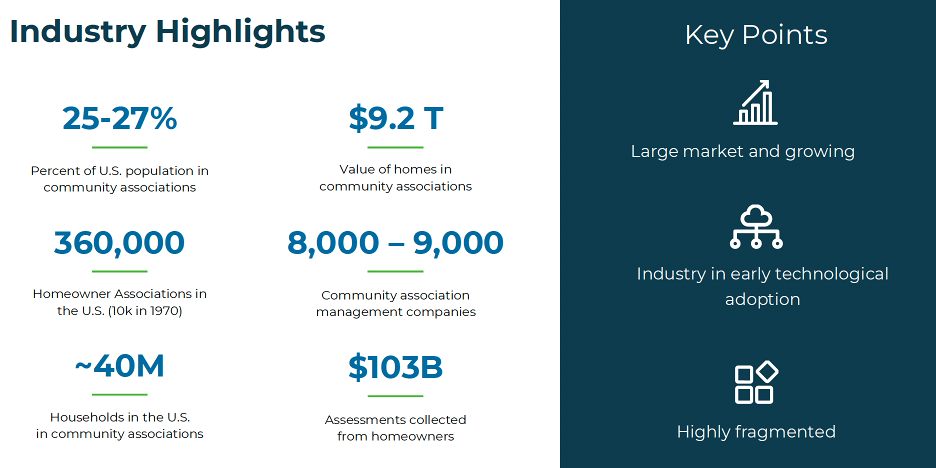
These community management companies share a common set of core objectives:
- Improve efficiency and scale without proportionally increasing headcount.
- Reduce operational bottlenecks in accounting, communications, and service delivery.
- Enhance homeowner satisfaction through faster, more transparent experiences.
- Focus staff on strategic, high-value work rather than routine administration.
Vantaca’s platform directly meets these needs by integrating AI-powered automation and digital knowledge worker agents into its core operations. They estimate that customers are already automating more than one million tasks annually, saving nearly 100,000 human hours and reallocating that time to teams for higher-value work. The company’s customer base now includes more than 500 association management companies, serving six million homes nationwide, with this number rapidly growing as digital transformation progresses across the industry.
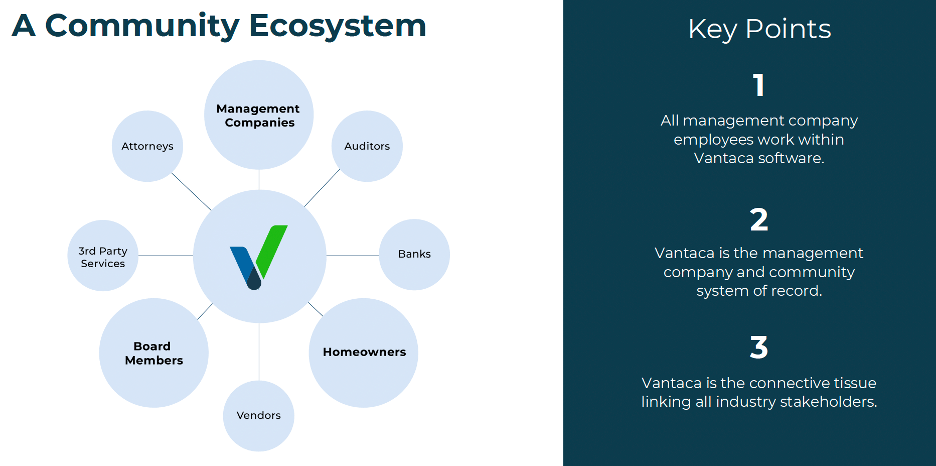
Their mission is to create the connective tissue among all stakeholders in the value chain, including homeowners, boards, vendors, and management teams. Vantaca is redefining how association management companies operate by shifting from fragmented systems toward a unified, AI-driven ecosystem that helps leaders modernize operations, boost profitability, and deliver exceptional homeowner experiences.
Watch the CUBE Conversation
Growth Fueled by Agentic AI
Over the past five years, Vantaca has consistently surpassed the broader SaaS sector, achieving compound growth six times the median and nearly twice the top-quartile benchmarks. With almost 6 million households managed through its platform and a 61 percent increase from 2023 to 2025, Vantaca is redefining the growth strategy for mid-market software vendors.
Currin attributes this momentum to relentless focus on customer pain points:
“Our growth has always been fueled by tackling the biggest friction points in this industry. AI poured gasoline on that fire by taking away the low-value work so our customers can focus on building relationships and solving problems that truly matter.”
Despite this significant footprint, the sector remains highly fragmented and early in its digital transformation, conditions that make it a prime target for AI-driven disruption. Management firms face pressure to expand services without increasing staff while also improving homeowner experiences in a market that relies heavily on relationships, transparency, and trust.
At the heart of Vantaca’s success is a bold digital labor strategy that embeds agentic AI into the daily fabric of community management work. Rather than bolting AI features onto legacy workflows, Vantaca has re-engineered its SaaS platform around digital coworkers that perform judgment-based tasks alongside humans. As Currin explained,
“We’ve shifted from UI-first and API-first to AI-first,” Currin said. “Everything our software does now must also work for AI agents, not just for people. That means designing every workflow so that a digital coworker can pick it up, understand context, and execute it end-to-end.”
This is where Vantaca’s strategy becomes transformative. The industry is shifting beyond simple task automation, such as processing invoices or sending notifications, and toward knowledge-worker agents that can reason, make judgments, and operate independently within set boundaries. These digital coworkers don’t merely execute scripts; they understand context, learn from results, and engage in workflows as collaborative team members.
Ben Currin believes that this approach is the breakthrough they needed to revitalize the industry they operate within:
“The real breakthrough isn’t automation, it’s augmentation. We’re creating AI coworkers that can apply reasoning and judgment to get work done, not just speed up repetitive tasks. That’s what allows management companies to scale without losing the human touch.”
This evolution reflects broader trends shown in theCUBE Research’s Digital Labor Transformation Index. While 73% of AI leaders agree that digital labor is inevitable, they are also increasingly describing it as collaborative intelligence, where humans and AI work together to improve decision-making. In fact, 64% of surveyed organizations expect AI agents to assist humans in knowledge work by supporting decision-making and problem-solving, and more than half anticipate them to pursue goals with minimal human guidance. The overall maturity index is 3.1 out of 5, indicating a slowly developing market, and Vantaca clearly surpasses it.
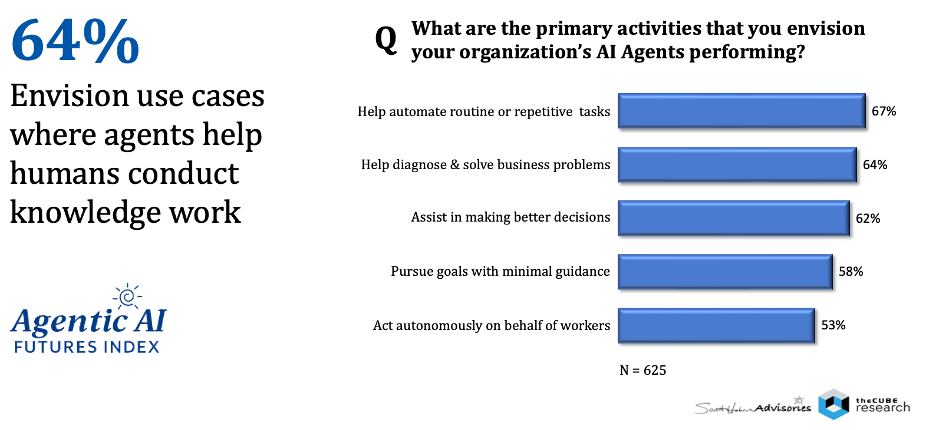
Within this context, Vantaca’s HOAi platform exemplifies the new digital labor model. Its agentic AI workers complete over a million workflows each year, managing both structured and judgment-based tasks, from reconciling budgets and approving invoices to directly engaging homeowners through empathetic voice interactions. These agents learn, adapt, and continually improve outcomes, enabling human staff to focus on strategic growth and relationship building.
“Our focus has always been on helping professionals deliver their service in a more value-added way,” Currin said. “Agentic AI gives them leverage, it lets people focus on what only humans can do: build trust, anticipate needs, and strengthen communities.”
The result is a redefinition of what “digital labor” means in the real world. Vantaca’s customers aren’t just automating workflows; they’re re-architecting their operations around hybrid human-AI teams. The platform’s AI agents act as digital knowledge workers, collaborating, reasoning, and delivering measurable results, turning software into a living, learning workforce that scales with business demand.
Customer Impact
Vantaca’s differentiation ultimately shows up in customer results. Clients are achieving measurable operational and experiential gains:
- Accounts payable automation is reducing invoice processing time from a week to 2 days and freeing staff for higher-value roles.
- Labor efficiency is automating 95% of A/P and accelerating invoices by 90%
- Voice AI engagement – HOAi Voice agents carry natural dialogues; many homeowners don’t realize they’re speaking with AI. It’s true, I saw it myself!
- Customer satisfaction – client scores and 5-star reviews continue to climb, especially for vendors and homeowners.
“What excites me most is when a homeowner calls our voice agent, asks about something as odd as their grass seed, and ends the call saying, ‘That was the best customer service experience I’ve had in years,” Currin said. “It shows that AI can enhance human connection, not replace it.”
Overall, community management companies that have “hired their AI agents” have completed over one million agentic tasks, saving nearly 70,000 human hours and an estimated $250 million in customer costs. Currin frames this as,
“AI that acts, not just answers questions. Our customers are experiencing AI that actually gets work done.”
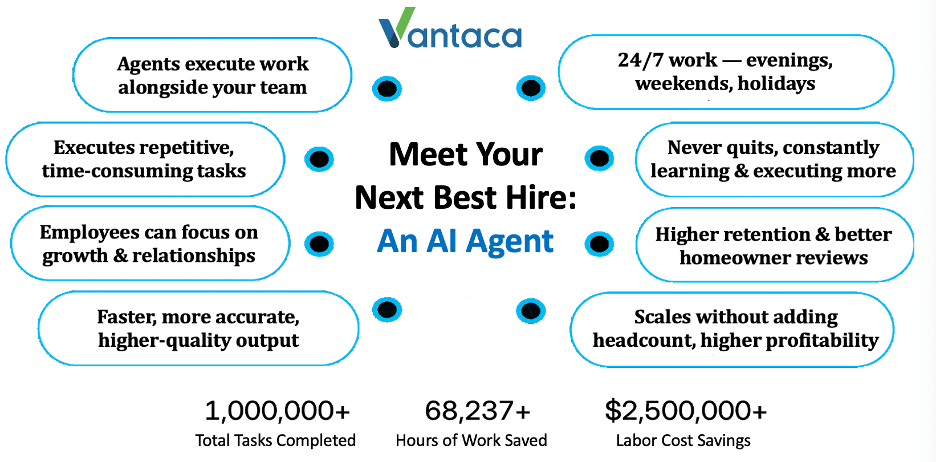
One of the most evident proofs of Vantaca’s agentic AI promise is in the Silverleaf Management Group. After adopting Vantaca and integrating HOAi, Silverleaf achieved a 600 percent growth in its portfolio without compromising resident experience, onboarding 51 acquired associations in the first year as planned. In just the first 60 days, HOAi agents completed over 4,000 tasks, saving more than 400 hours of busywork across accounting, communications, and service workflows. Phone wait times dropped from 4 minutes to just 3 seconds, enabling more responsive service on a larger scale. As Silverleaf CEO Lisa Turner stated,
“We count HOAi AI Agents as employees. The math is crazy when you save that much time. We can easily and rapidly scale with AI, taking on the increased workload.”
In effect, Silverleaf didn’t just adopt task automation; they transformed their operating model by boosting the effectiveness and speed of knowledge work. The early results are impressive.
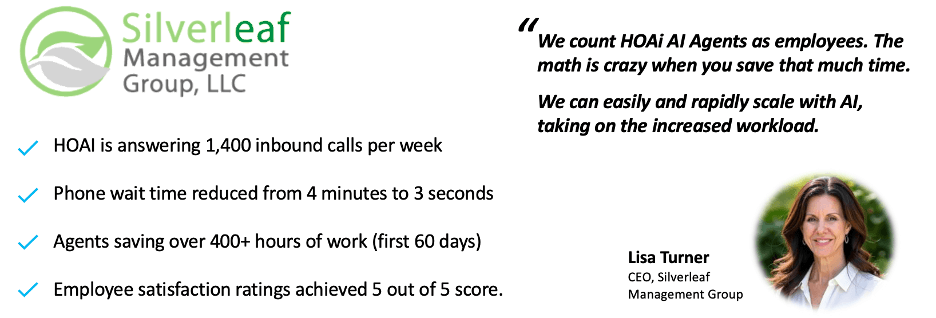
By combining automation, reasoning, and judgment, Vantaca is turning software into a digital workforce that augments human talent. These outcomes exemplify what Currin calls the customer-success flywheel:
“When our customers capture results, they grow their business and expand with us. That’s how you build a movement, not just a software company.”
Our Analysis
Vantaca’s rise from regional SaaS vendor to national unicorn captures the essence of today’s Agentic AI super-cycle, a generational transition from process automation to outcome-driven digital labor.
Yet what truly distinguishes the company is how it has operationalized that shift. Through its integration of HOAi, Vantaca has transformed the potential of agentic AI into a scalable, real-world business model—one that not only deploys AI but also builds a sustainable digital workforce. Moreover, its emphasis on targeted vertical markets, measurable ROI, and a trust-based control culture sets a benchmark for how specialized software companies can lead AI transformation.
As Scott Hebner, principal analyst at theCUBE Research, observed:
“Vantaca isn’t just modernizing community management; it’s reinventing what work looks like in this industry. It’s the embodiment of the digital labor transformation now underway across enterprises everywhere. They’ve validated the secrets to success in turning agentic technologies into business results.”
That transformation did not happen by accident. In a Next Frontiers of AI podcast conversation with Haoyu Zha, HOAi’s founder, now part of Vantaca’s leadership, identified clear success factors, principles that explain how to turn agentic AI technologies into lasting business advantages.
They included four key imperatives:
1. Rethink Software Bottoms Up
Zha explained that generative AI serves as the “gateway” into the AI world, much like browsers were to the internet. The key is to move up the software value stack. True differentiation happens in the next higher layer, the application and workflow layer, where agentic systems link reasoning models with real-world actions, all based on existing SaaS and software stacks.
“Agentic AI is where AI moves from generating answers to getting work done,” Zha said. “It’s about using generative intelligence to reason through context, make judgments, and create real-life impact.”
Vantaca embraced this philosophy by integrating HOAi’s digital coworkers into the core functions of community management, overseeing end-to-end invoices, budgets, homeowner interactions, and vendor coordination. This transition from simple “text in, text out” AI to AI that actively engages resulted in tangible, measurable outcomes for clients: millions of tasks automated, hundreds of thousands of hours saved, and consistent improvements in satisfaction and profitability.
2. Go Vertical In Nuanced Markets
Zha emphasized that the next wave of AI opportunity lies in vertical specificity, not horizontal scale. More importantly, it’s about how workers in that vertical category make judgments and decisions, focusing on knowledge work rather than just launching task automations. Foundation models may become commoditized, but domain-tuned agentic systems, designed for industries with high labor spend and judgment-based work, can deliver disproportionate value.
“There are infinite real-world situations that foundation models can’t cover,” he noted. “The value is in the business layer—the unique workflows, interfaces, and decisions that define how people actually get work done.”
The insight proved prophetic: by aligning AI agents with the micro-judgments required in community management, Vantaca captured a massive labor-intensive segment that traditional software couldn’t reach with SaaS and cross-industry solutions.
3. Target Labor Spend, Not IT Budgets
Building on their vertical focus, HOAi and Vantaca’s model recognized that AI’s biggest opportunity lies in labor, not technology budgets. While traditional enterprise software historically accounted for 2-3% of business spending, labor costs exceed 50% of operating costs in most industries. The advent of agentic AI now allows software companies to target labor comprehensively and in an outcome-focused way. They jumped on this much earlier than most.
“Agentic AI opens up a 10× bigger market. We’re not just automating IT workflows; we’re transforming the workforce itself. It’s about AI that not only responds, but decides and acts in concert with human knowledge workers”
By deploying AI coworkers to handle operational tasks, Vantaca enables management companies to grow without proportionally increasing their staff and allows their human employees to focus on higher-value, more satisfying activities. Essentially, it grants them new “superpowers” to accomplish much more with minimal additional investment. This is how they help their customers turn AI adoption into direct growth and margin expansion.
4. Create Trust Between Humans and Agents
Both leaders underscored that success depends on designing for trust, governance, and collaboration, not replacement. As Zha put it,
“We think of ourselves as an HR company providing digital workers. The key is helping leaders manage AI agents like people—measuring performance, building confidence, and improving them over time.”
This insight aligns with theCUBE Research’s Agentic AI Transformation Index, which found that while fewer than half strongly trust AI agents to make decisions and act autonomously, 69% feel that focusing on better collaboration, explainability, and accountability would improve trust in outcomes. Vantaca and HOAi have built the trust and governance architecture needed to scale digital labor responsibly.
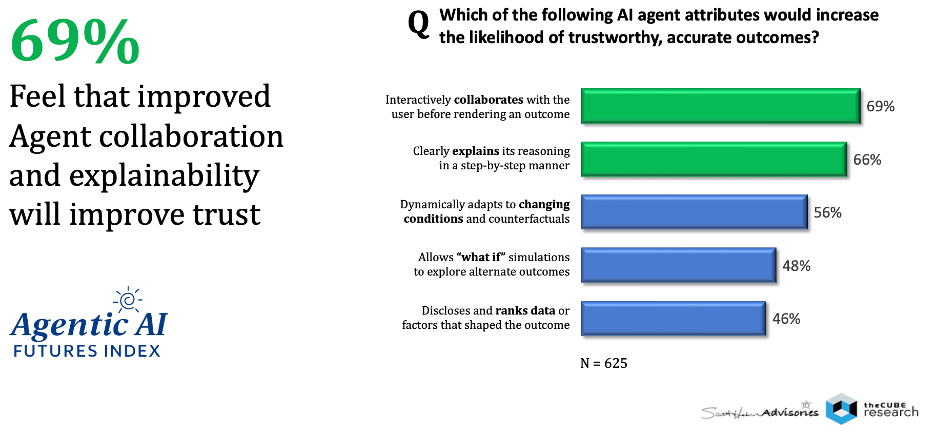
Together, these principles create a “blueprint for agentic AI success,” a model that combines deep insight, AI reasoning, and digital labor management to drive exponential growth. From an analyst’s viewpoint, Vantaca and HOAi’s achievements highlight a crucial turning point for the software industry. As Hebner summarized in the Next Frontiers of AI podcast:
“The winners in this new era will be those who turn AI from an assistive tool into a true workforce, AI that can reason, act, and deliver outcomes you can trust. It’s about digital labor infusion, not just process automation.”
What gives Vantaca a durable competitive advantage is not just its rapid growth, but its architecture and outcomes. While many legacy players (such as CINC and similar workflow-automation incumbents) are built around rigid, rules-based workflows and UI-driven forms, Vantaca’s platform is AI-native from the ground up.
The HOAi engine forms the core of its architecture, meaning that intelligent agents, not just rule-based triggers, drive knowledge work and process execution. These agents reason, adapt, and coordinate across modules, instead of merely routing tasks through static queues. This allows Vantaca to deliver measurable business outcomes, not just faster workflows. While legacy systems might offer “automation modules,” Vantaca can promise, prove, and scale “digital labor units” that reclaim hours, reduce errors, and optimize decisions end-to-end.
In contrast, workflow-first systems often struggle with scaling complexity and adaptable, judgment-based reasoning: as you add more rules, edge cases multiply, requiring heavy customization and increasing maintenance costs. Vantaca’s architecture, however, is compositional, dynamically adaptable, and learning-based: new use cases can be managed by agents that leverage prior experience, shared context, and feedback loops. Over time, the platform becomes smarter, more autonomous, and less fragile.
Vantaca is one of the earliest and clearest examples of that future: a company built on SaaS, enhanced by agentic AI, and driven by the belief that trust, reasoning, and collaboration between humans and software agents will transform how businesses operate, create value, and engage with the world, sparking a new super cycle of business innovation and productivity.
There are lessons in this success story for all companies, of all types and sizes.
As Peter Drucker, widely regarded as the father of modern management and one of the most influential business thinkers of the 20th century, once said:
“The best way to predict the future is to create it—and the surest way to create it is to study those who already have.”
—– Subscribe to the Next Frontiers of AI Digest to get summaries of my latest research.


